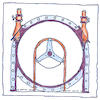Nikola Tesla
fluid dynamics

|
Tesla turbine
Referred to as a bladeless turbine, the Tesla turbine isn’t really bladeless, but has many smooth disks that lie along the line of flow and not athwart it. The surface layer of the moving fluid spins the disks by adherence according to what is called the boundary-layer effect.
A challenge
Disks in the Tesla turbine are smooth. Without vanes to be torqued by the flow, they are more sturdy. But the need for the disks to be thin to reduce warping from turbulence at the edges of the disks was a challenge.
Tesla pump
In practice, Testla turbines were less efficient than conventional turbines. But if you power the Tesla turbine, it becomes a pump which, owing to its lack of vanes, can be used to pump waste materials that contain solids that would block a normal pump.



Nikola Tesla developed his turbine to produce energy using steam as the moving fluid. His claim that a given turbine would work well with either steam or fluids is not correct, since the spacing between disks must be close to the thickness of the boundary layer of the fluid, which depends on viscosity and pressure.
See also in The book of science:
Readings in wikipedia: